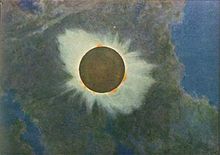User:Maplestrip/Solar eclipses in art

Solar eclipses are a recurring subject of painting and photography.
Prehistory and antiquity
[edit]Very few prehistoric depictions of solar eclipses have been found. Some experts[who?] suggest this may be because solar eclipses were regarded as bad omens by many ancient civilizations, and Karl Kusserow of Princeton University said that rock carving was a laborious effort for drawing "the worst of all times." Within Norse mythology, solar eclipses were depicted as the wolves Sköll and Hati chasing the sun and moon across the sky. Within Chinese mythology, solar eclipses were depicted as a dragon devouring the sun.[1]
An Ancestral Puebloan petroglyph resembling a coronal mass ejection was discovered in Chaco Canyon in 1992. Archaeoastronomer Kim Malville connected the carving with the solar eclipse of July 11, 1097, which passed over the pueblos. The sun was at a maximum of its magnetic activity, which makes an occurrence of coronal mass ejection more likely. Malville suggested that this depiction would indicate a positive relationship with solar eclipses.[2]
Early modern depictions
[edit]
Modern depictions
[edit]
Photography
[edit]
The first successful photograph taken of a solar eclipse was that of the July 28, 1851 eclipse, taken by Julius Berkowski. Commissioned by the Royal Prussian Observatory at Königsberg, Berkowski used the "state of the art" daguerreotype process to capture the Sun's corona in contrast with the darkness of the Moon. Other photographers attempted to picture solar eclipses before, but failed due to the long exposure requirements of 19th-century photography.[3]
In film and fiction
[edit]References
[edit]- ^ Brandon, Elissaveta M. (2024-04-04). "The Long History of Art Inspired by Solar Eclipses". Smithsonian Magazine.
- ^ Panko, Ben (2017-08-17). "This New Mexico Petroglyph Might Reveal an Ancient Solar Eclipse". Smithsonian Magazine.
- ^ Farber, Madeline (2017-08-11). "This Is the First-Ever Photo of a Total Solar Eclipse". Time Magazine.
reflist:
- Blatchford, Ian (2016-09-28). "Symbolism and discovery: eclipses in art". Philosophical Transactions. The Royal Society.
- Boyle, Rebecca (2016-09-02). "How Artists Have Depicted Eclipses Across History". The Atlantic.
- Woo, Richard (July 2016). "The Art and Science of Solar Eclipses". American Scientist. (modern)
- Pasachoff, Jay M.; Olson, Roberta J.M. (2014-04-16). "Astronomy: Art of the eclipse". Nature.
- Moore, Christian (2024-03-26). "Total eclipse of the art: How the disappearing sun has long captivated the creative imagination". Euronews. (literature, pop culture, omens?)
- Kelly, Colleen (2024-03-28). "NASA Artists Are Creating Eye-Popping Posters for the Eclipse". Atlas Obscura.
- "Solar eclipses: heaven-sent chance to mix art and science". New Scientist. 2016-07-24. (very marginal use, clone of Phil Trans)
- Triplett, Kyle (2017-08-17). "Total Eclipse of the Art: Trouvelot and the 1878 Eclipse". nypl.org. New York Public Library. Archived from the original on 2021-03-12. (1878, Trouvelot)
- Bradner, Liesl (2017-08-19). "Solar eclipse: Artists turn to science in rendering the emotion of past eclipses". The LA Times. (2017 paintings)
- Schwab, Katharine (2017-08-21). "700 Years Of Art Inspired By Eclipses". Fast Company. (Princeton, 1918 Howard Russell Butler, 1500s Antoine Caron)
- Farago, Jason (2017-08-17). "How Do You Paint an Eclipse? Work Fast in the Dark". The New York Times. Archived from the original on 2017-08-23.</ref> (1918 Butler)
- https://www.space.com/37806-solar-eclipse-art-by-howard-russell-butler.html (more Butler/Princeton)



